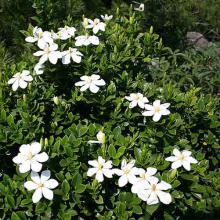Gardenia jasminoides
Common name:
Gardenia
Genus:
Gardenia
Family:
Rubiaceae
Order:
Gentianales
Gardenia jasminoides
Common name:
Gardenia
Genus:
Gardenia
Family:
Rubiaceae
Order:
Gentianales
Gardenia jasminoides
Common name:
Gardenia
Genus:
Gardenia
Family:
Rubiaceae
Order:
Gentianales
Family (Plantae): Rubiaceae
The Rubiaceae are a family of flowering plants, commonly known as the coffee, madder, or bedstraw family. It consists of terrestrial trees, shrubs, lianas, or herbs that are recognizable by simple, opposite leaves with interpetiolar stipules and sympetalous actinomorphic flowers. The family contains about 13,500 species in about 620 genera, which makes it the fourth-largest angiosperm family. Rubiaceae has a cosmopolitan distribution; however, the largest species diversity is concentrated in the tropics and subtropics. Economically important species include Coffea, the source of coffee, Cinchona, the source of the antimalarial alkaloid quinine, some dye plants (e.g., Rubia), and ornamental cultivars (e.g., Gardenia, Ixora, Pentas).
Description
The Rubiaceae are morphologically easily recognizable as a coherent group by a combination of characters: opposite leaves that are simple and entire, interpetiolar stipules, tubular sympetalous actinomorphic corollas and an inferior ovary.
A wide variety of growth forms are present: shrubs are most common (e.g. Coffea, Psychotria), but members of the family can also be trees (e.g. Cinchona, Nauclea), lianas (e.g. Psychotria samoritourei), or herbs (e.g. Galium, Spermacoce). Some epiphytes are also present (e.g. Myrmecodia). The plants usually contain iridoids, various alkaloids, and raphide crystals are common. The leaves are simple, undivided, and entire; there is only one case of pinnately compound leaves (Pentagonia osapinnata). Leaf blades are usually elliptical, with a cuneate base and an acute tip. In three genera (Pavetta, Psychotria, Sericanthe), bacterial leaf nodules can be observed as dark spots or lines on the leaves. The phyllotaxis is usually decussate, rarely whorled (e.g. Fadogia), or rarely seemingly alternate resulting from the reduction of one leaf at each node (e.g. Sabicea sthenula). Characteristic for the Rubiaceae is the presence of stipules that are mostly fused to an interpetiolar structure on either side of the stem between the opposite leaves. Their inside surface often bears glands called "colleters", which produce mucilaginous compounds protecting the young shoot. The "whorled" leaves of the herbaceous tribe Rubieae have classically been interpreted as true leaves plus interpetiolar leaf-like stipules. The inflorescence is a cyme, rarely of solitary flowers (e.g. Rothmannia), and is either terminal or axillary and paired at the nodes. The 4-5-merous (rarely pleiomerous; e.g. six in Richardia) flowers are usually bisexual and usually epigynous. The perianth is usually biseriate, although the calyx is absent in some taxa (e.g. Theligonum). The calyx mostly has the lobes fused at the base; unequal calyx lobes are not uncommon, and sometimes (e.g. Mussaenda) one lobe is enlarged and colored (a so-called “semaphyl”). The corolla is sympetalous, mostly actinomorphic, usually tubular, mostly white or creamy but also yellow (e.g. Gardenia spp., Mycelia basiflora), and rarely blue (e.g. Faramea calyptrata) or red (e.g. Alberta magna, Ixora coccinea). The stamens are alternipetalous and epipetalous. Anthers are longitudinal in dehiscence, but are poricidal in some genera (e.g. Rustia, Tresanthera). The gynoecium is syncarpous with an inferior ovary (rarely secondarily superior, e.g. Gaertnera, Pagamea). Placentation is axial, rarely parietal (e.g. Gardenia); ovules are anatropous to hemitropous, unitegmic, with a funicular obturator, one to many per carpel. Nectaries are often present as a nectariferous disk atop the ovary. The fruit is a berry, capsule (e.g. Oldenlandia), drupe (e.g. Coffea, Psychotria), or schizocarp (e.g. Cremocarpon). Red fruits are fairly dominant (e.g. Coffea arabica); yellow (e.g. Rosenbergiodendron formosum), orange (e.g. Vangueria infausta), or blackish fruits (e.g. Pavetta gardeniifolia) are equally common; blue fruits are rather exceptional save in the Psychotrieae and associated tribes. Most fruits are about 1 cm in diameter; very small fruits are relatively rare and occur in herbaceous tribes; very large fruits are rare and confined to the Gardenieae. The seeds are endospermous.
Distribution and habitat
Rubiaceae have a cosmopolitan distribution and are found in nearly every region of the world, except for extreme environments such as the polar regions and deserts. The distribution pattern of the family is very similar to the global distribution of plant diversity overall. However, the largest diversity is distinctly concentrated in the humid tropics and subtropics. An exception is the tribe Rubieae, which is cosmopolitan but centered in temperate regions. Only a few genera are pantropical (e.g. Ixora, Psychotria), many are paleotropical, while Afro-American distributions are rare (e.g. Sabicea). Endemic rubiaceous genera are found in most tropical and subtropical floristic regions of the world. The highest number of species is found in Colombia, Venezuela, and New Guinea. When adjusted for area, Venezuela is the most diverse, followed by Colombia and Cuba.
The Rubiaceae consist of terrestrial and predominantly woody plants. Woody rubiaceous shrubs constitute an important part of the understorey of low- and mid-altitude rainforests. Rubiaceae are tolerant of a broad array of environmental conditions (soil types, altitudes, community structures, etc.) and do not specialize in one specific habitat type (although genera within the family often specialize).
Reference: Wikipedia

